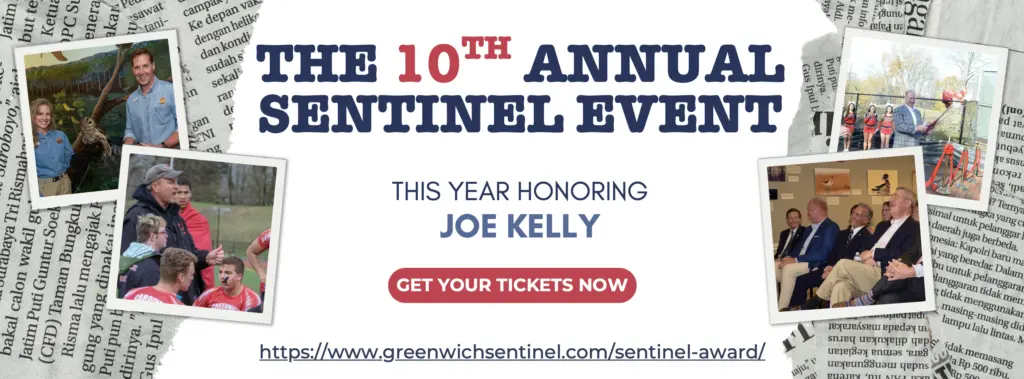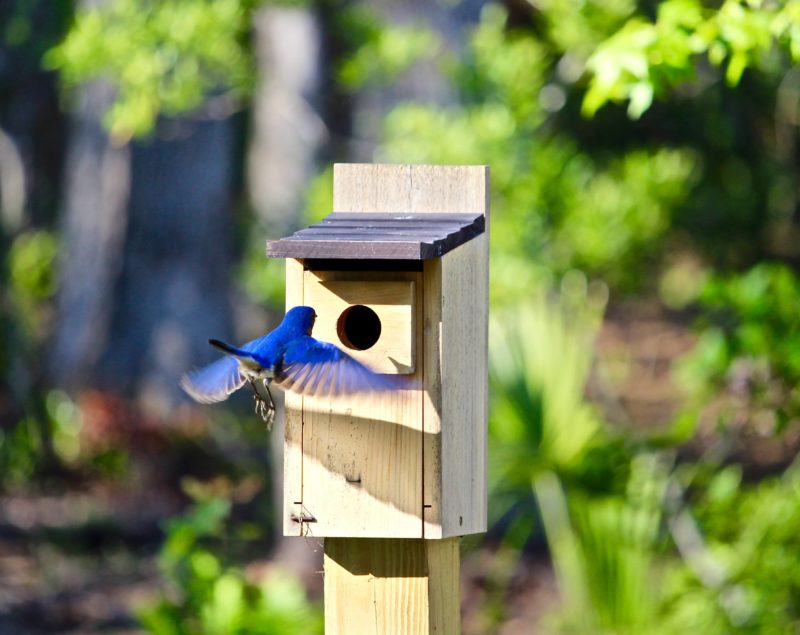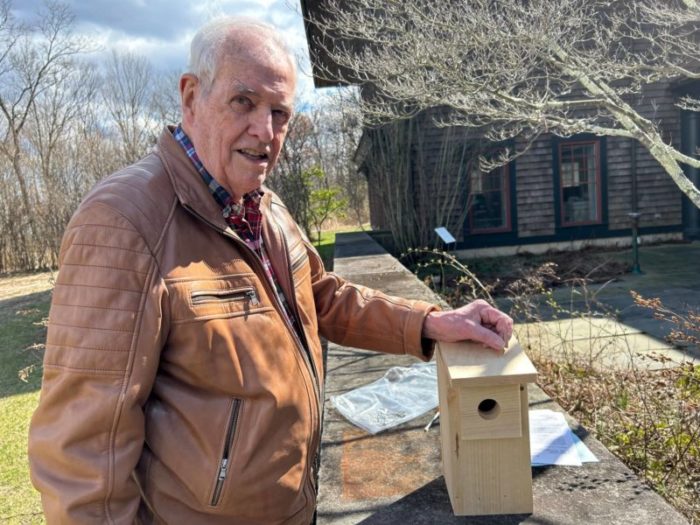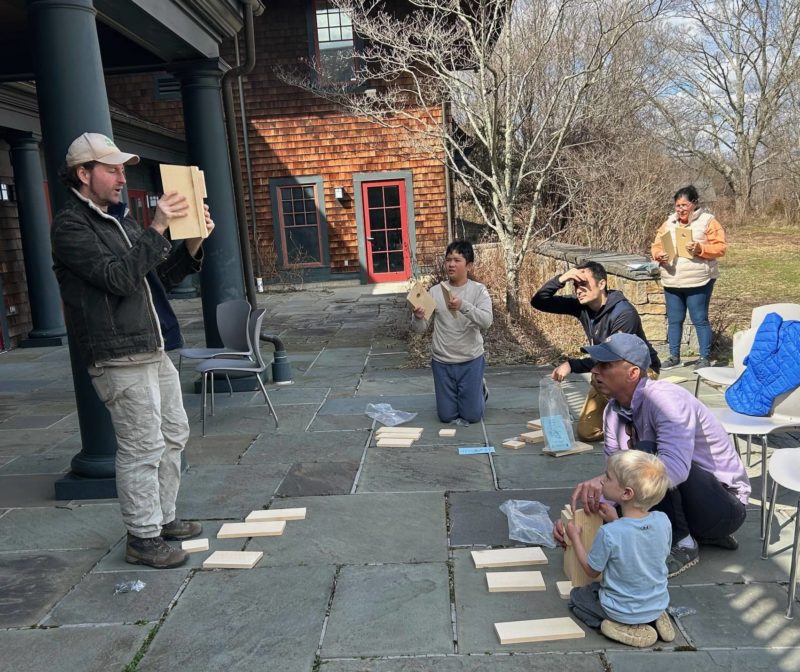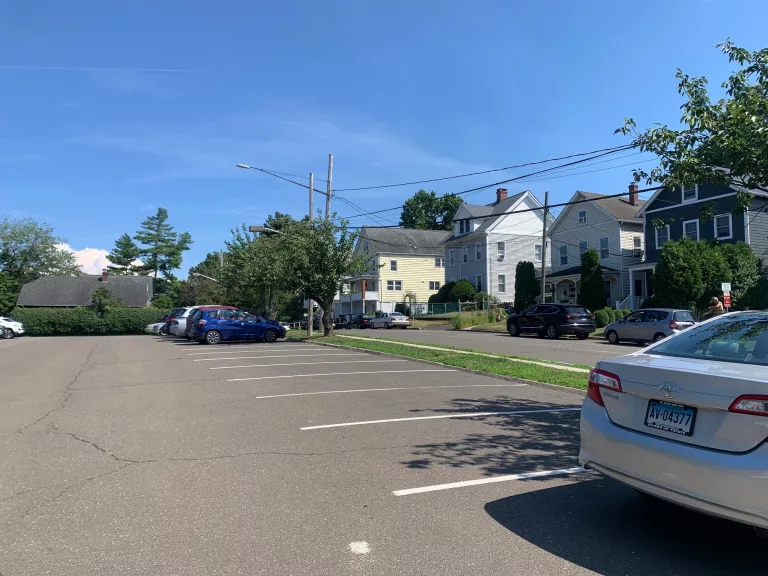By Anne W. Semmes
Spring has sprung and soon those Eastern Bluebirds will be returning from tropical climes to grace Greenwich again – and needing housing! So shared Ryan MacLean, Senior Education Coordinator at the Audubon Center, at his informative program last Saturday on how to build nest boxes for these lovely birds now being challenged to find natural tree cavities in the wild.
“You see the picture of the male Eastern Bluebird carrying a worm,” he shows of the bird arriving at a nest box, “Hopefully some babies that are inside that box are going to be able to survive and find the right habitats to live in.” He welcomed the dozen attending who had each invested $40 for a nest box kit and to learn how they could build and play a part in providing shelter. Those nest boxes are making a difference MacLean tells. “About 50 years ago, there were not nearly as many Bluebirds as there are today, and that’s all thanks to the amount of people that started putting up bird houses for them.”
So, what else are those Bluebirds looking for? Caterpillars. “At this time of year, they’re looking for caterpillars… And if you don’t have native plants, trees and shrubs, you don’t have nearly as many caterpillars.” And “When they’re starting to get ready to nest, when those babies are born, they have to feed them about 2,000 caterpillars per day…So, the more habitat you have for birds like this, the more food options they will have and that’s going to make sure that these birds are able to survive.”
And those Bluebirds will need water. “Water is just as important to birds as it is to us,” says MacLean. “And water features not only look great but are really nice in gardens, but they can be a lifesaving source for so many birds. You can even design water features that have running water if you’re able to, which birds when they see that, especially if they’re migrating and they’ve been flying all night and they’ve come across from the tropical rainforest for the winter, they see that and they’re like, oh my goodness, it’s like an oasis in the desert right here.”
MacLean then zeroes in on the inside of that nest box. He opens a nest box and holds it close to a transfixed five-year-old boy attending also called Ryan. With a Bluebird nest, “You see there a very fine layer of grasses.” But with an invading House Wren, you’ll find “a big wad of sticks.” “And if you thought the Bluebird nest looked pretty with just that little thin layer of grasses,” he adds, the invading “Tree Swallows are ultimate artisans in building their nests – they find soft feathers of other birds,” including from a chicken “from a nearby farm, using that as an even softer pillow lining for those beautiful little white eggs -which might be half a dozen inside your nest.”
So when the nest feeding begins, “If one has an insect in its mouth,” MacLean notes, “It’s probably feeding either the female that’s on eggs or eventually you’ll see little heads sticking out in the box, and they have for their eggs about two to seven eggs that they might lay in a 13 to 20 day incubation period….That’s the amount of time it’ll take before the eggs hatch, and it doesn’t take long for them to get to be full size a little bit less than a month.”
And Bluebirds he tells “have multiple broods in a year…So, the first clutch may come out around May and the second maybe around July, then maybe another in August.” He warns “Now these birds are all protected by law federally by the Migratory Bird Treaty Act, so, unless you are a licensed bird researcher or bander, you can’t pick the birds up or pick up the eggs even.”
But you can safely monitor your Bluebirds tells MacLean. “You can look inside and check on them by lifting up the door of your nest box to briefly see how many eggs are inside, but you don’t want to be intrusive to them. You could even quickly take a picture with your iPhone, close the box, and let the parents get back to doing their work. And that can help to keep a very important track of how many eggs they have, how many young they have and what the status of their life cycle is.” MacLean also shared the option of signing onto the Cornell Laboratory of Ornithology Nest Watch website at nestwatch.org. “You can create an account that lets you enter your nest box…and as a bird family moves in, you get to check on it and enter what you see or what you observe every time you check that box…and all that information goes to researchers at Cornell to help make sure that our bird populations are staying healthy.”
But MacLean returns to the duties of “bird landlords…and the most important part of that is making sure we clean our nest boxes….It is very much advised at the end of each bird breeding season to remove all of the nesting material out of the box because insects can form mites that can form diseases that can accumulate in the box and get the birds sick if they come back and it’s not cleaned out….then cleaning it out with a solution of one part bleach to nine parts water, rinsing them out, letting them dry out so that they’re ready to go for when our birds want to move back into them.” And fair warning, “if a box is left unattended, you might get unwanted winter residents.”
Also important tells MacLean is where to situate your nest box. “You can attach it to a fence post or the side of a tree, but you can also get sturdy poles for them. We do sell poles in our store.” And “For a Bluebird or a Tree Swallow, you want open space where there aren’t too many trees on each side. And “face the entrance of the box east, so they get that sunlight first thing in the morning and that’s going to be what they prefer.” And for those setting out more than one nest box, “space them about 15 to 20 feet apart to make sure that there isn’t, ‘Hey, this is my spot. No, this is my spot.’”
Lastly, to avoid those predators like raccoons from getting into your nest boxes, he recommends “putting up baffles to protect the poles of the nest so they can’t climb up them,” also for sale at Audubon. “Animals like snakes can’t get above that as easily as well.” Then there’s additional things one can add at the nest box entrance, to block out those predator paws, but it was time to go outside with the nest box kits and get them built. Particularly eager to begin was five-year-old Ryan seen determinedly doing his part with a hammer.
News alert: Audubon educator Ryan MacLean is holding a second Nest Box Building Workshop Saturday, March 30, from 1 to 3 p.m. To register visit greenwich.audubon.org/events
